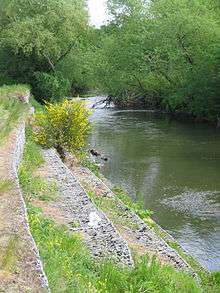Bank erosion
Bank erosion is the wearing away of the banks of a stream or river. This is distinguished from erosion of the bed of the watercourse, which is referred to as scour.
The roots of trees growing by a stream are undercut by such erosion. As the roots bind the soil tightly, they form abutments which jut out over the water. These have a significant effect upon the rate and progress of the erosion.[1]
Measurement
Erosion and changes in the form of river banks may be measured by inserting metal rods into the bank and marking the position of the bank surface along the rods at different times.[2] This simple measurement technique can be enhanced with the use of a data logger attached to a rod of photoreceptors; the logger records the voltage, which is an indication of how much of the rod is exposed.[3]
Control
Bank erosion is a natural process: without it, rivers would not meander and change course. However, land management patterns that change the hydrograph and/or vegetation cover can act to increase or decrease channel migration rates. In many places, whether or not the banks are unstable due to human activities, people try to keep a river in a single place. This can be done for environmental reclamation or to prevent a river from changing course into land that is being used by people. One way that this is done is by placing riprap or gabions along the bank. A common natural method to reduce bank erosion is the re-introduction of native plant species in the area. The expansive root systems of these plants provide support within the soil and prevents erosion due to rain runoff.
References
- ↑ Ian Rutherford, James Grove (2004), "The Influence of Trees on Stream Bank Erosion", Riparian vegetation and fluvial geomorphology, ISBN 978-0-87590-357-6
- ↑ Nancy D. Gordon (2004-06-01), "Erosion and Scour", Stream hydrology: an introduction for ecologists, ISBN 978-0-470-84357-4
- ↑ Lawler, D. M. (1992), "Design and installation of a novel automatic erosion monitoring system", Earth Surface Processes and Landforms, 17 (5): 455, Bibcode:1992ESPL...17..455L, doi:10.1002/esp.3290170505.
